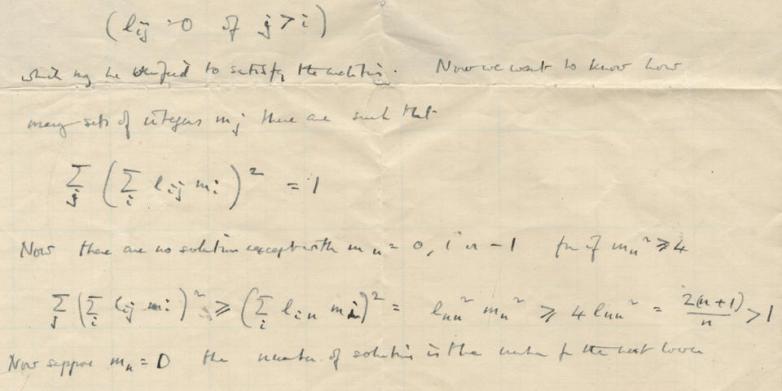Alan Turing's Bletchley Park Recreational Maths to Auction

Autograph mathematical calculations setting out and solving a problem in n-dimensional geometry, 2 pages, Bletchley Park, 1941 or 1942.
When they weren't working on helping to defeat Hitler, the codebreakers at Bletchley Park in England would often relax by tackling puzzles. A newly discovered set of calculations written by Alan Turing in a moment of downtime provide, in the words of Distinguished Professor Jack Copeland, Director of the Turing Archive for the History of Computing, "an excellent example of the recreational mathematics that went on at Bletchley Park".Offered at Bonhams Fine Books & Manuscripts Sale on March 29, the newly discovered document is estimated at £20,000-30,000 ($24,350-36,525).
The calculations – which set out and analyse a problem in n-dimensional geometry – were written in ink on two pages of mathematical paper and discovered among the papers of Rolf Noskwith who worked alongside Turing in Hut 8 at Bletchley Park from June 1941 until the autumn of 1942 when Turing left for America to assist the US Navy's codebreakers. The undated pages had been folded in two and ROLF scribbled on the back.
Sarah Lindberg, senior specialist at Bonhams Fine Books and Manuscripts department, said: "These calculations are not simply a complex mathematical exercise, they also show the all-pervasive culture of intellectual enquiry and collaboration among the Bletchley Park recruits. By their nature, Turing and his colleagues had a great love of problem solving and puzzles of all sorts so we should not be surprised that this continued alongside their more serious work on codebreaking."
There were, of course, many other activities at Bletchley Park to occupy the leisure hours of the many people who worked there - tiddlywinks, table-tennis, rounders, tennis, cricket, musical societies and much else. In his recollections of his time at Bletchley Park, published in Hut 8 from the Inside, (The Bletchley Park Code-Breakers, edited by Ralph Erskine and Michael Smith), Rolf Noskwith talks of the active Dramatic Society who "...put on plays and reviews of a high standard, there was a lot of music and we played chess and bridge. Most men went about in old sports jackets and shabby corduroy trousers. Once when a visiting Admiral was taken around the site by the Director he is reported to have asked: 'What are all these velvet arsed bastards doing here?"
Rolf Noskwith (1919-2017), mathematician, cryptographer and businessman, was born in Germany but fled to England in 1932. Educated at Nottingham High School and Trinity College Cambridge, he was 22 when he was assigned to Hut 8 under Alan Turing to work on German Naval Enigma ciphers. In February 1942 Hut 8 took on the challenging task of breaking the new Shark four-rotor Enigma machine and by June 1943 had developed the technical capability to keep abreast of German intelligence, with Noskwith one of just four codebreakers still working in that section.
An archive of papers from his time as a codebreaker at Bletchley Park, with further family correspondence, personal and business papers are estimated at £1,000-1,500 ($1,217-1,826). Other highlights include:
- On the Origin of Species by Charles Darwin, first edition, John Murray, 1859
- Annotated typescripts from Finnegans Wake by James Joyce, mainly Paris, 1936-37
- Illuminated Manuscript Book of Hours on vellum in Latin, with calendar in French, Flanders, probably Bruges, mid 15th century
- Casino Royale by Ian Fleming, first edition, Jonathan Cape, 1953
- Banks' Florilegium by Joseph Banks and James Cook, 35 parts in 11 vol., Alecto Historical Editions, 1980-1990
- Papers from the collection of Sir Albert George Allen (1888-1956), solicitor to the Duke of Windsor during the abdication of Edward VIII















